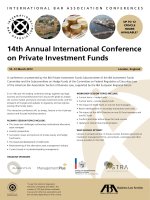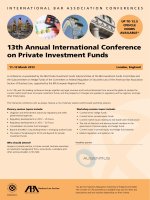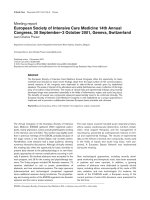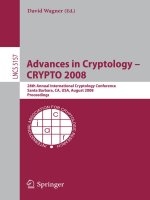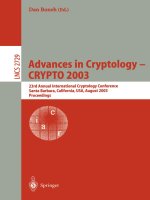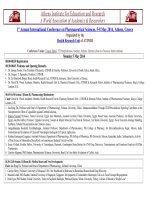14th ANNUAL INTERNATIONAL AESTHETIC WEEK
Bạn đang xem bản rút gọn của tài liệu. Xem và tải ngay bản đầy đủ của tài liệu tại đây (463.75 KB, 5 trang )
8/11/15
New York University College of Dentistry
Linhart Continuing Dental Education Program
“Current Concepts in American Dentistry:
Advances in Aesthetics and Oral Rehabilitation”
March 14-18, 2016 (Monday - Friday)
14th ANNUAL INTERNATIONAL AESTHETIC WEEK
NYUCD International Weeks are open to all dentists throughout the world including dentists from the United
States. All programs are in English. When appropriate, translation from English to other languages may be
provided. These special weeks (Monday thru Friday) often attract dentists from as many as ten countries. While
no “hands-on” laboratory sessions are included, participants “learn from the experts” through lecture, group
discussions and “live” patient demonstrations when appropriate to enhance the learning experience.
PROGRAM DIRECTOR:
Dr. Stephen CHU
Dr. Chu is a Clinical Associate Professor in the Ashman Department
of Periodontology and Implant Dentistry at New York University
College of Dentistry. He maintains a private practice in fixed
prosthodontics, esthetic, and implant dentistry in New York City. Dr.
Chu has published extensively in the dental literature and has given
lectures nationally and internationally on the subjects of esthetic,
restorative, and implant dentistry. Dr. Chu is on the editorial review
board of several peer-reviewed dental journals. He is the recipient of
the Dr. Peter Scharer Distinguished Lecturer Award from the European Academy of
Esthetic Dentistry. Dr. Chu is the creator of Chu’s Aesthetic Gauges manufactured by
Hu-Friedy Co., Inc.
Monday, March 14, 2016. . . . . . . . . . . . . . . . . . . . . . . . . . . . . . . . . . . . . . . . . . . . . .
9:00 a.m. – 4:00 p.m.
Dr. Stefano GRACIS
D.M.D. degree at the University of Pennsylvania and the University
of Pavia (Italy). Certificate in Prosthodontics with an M.S.D.
degree at the University of Washington in Seattle under the
guidance of Dr. Ralph Yuodelis. Private practice limited to
prosthodontics and restorative dentistry in Milan. Active member
of the Italian Academy of Prosthetic Dentistry (AIOP) for which
he was President in the years 2007-2008 and of the European Academy of Esthetic
Dentistry (EAED) for which he is a member of the Executive Board and PresidentElect. Member of the Editorial Board of the International Journal of Prosthodontics and
International Journal of Esthetic Dentistry. Author of several articles and chapters in the
field of restorative dentistry and frequent lecturer on topics related to fixed
prosthodontics and implant prosthodontics.
“Materials Selection for Teeth and Implants in the Esthetic Zone”
Up to now, metal-ceramics has been considered the gold standard for fabricating fixed prosthesis since it
reconciles excellent mechanical and physical properties with the ability to deliver, at least in many situations, a
satisfactory aesthetic appearance. In the past three decades, the advent of metal free ceramic materials and
systems has attempted to challenge this standard. The introduction of these materials has increased the choice, but
also the confusion and uncertainty among dental professionals. While providing better esthetics more easily, many
of these products have proven to be short lived and erratic in behavior once cemented in the oral cavity.
This program will analyze whether metal-ceramic prosthesis are still indicated while addressing the relative
advantages, disadvantages and potential risks for failure of the metal free materials. An effort will be made to
explain the real differences among the various types and brands of all ceramic and ceramic-like restorations.
Variables such as single crowns vs. bridges, the color of the substrate, the shape and position of the preparation
margin, the ease of use and marginal precision of the materials, and the accessibility of the finish line for an
adhesive cementation will be critically analyzed and discussed.
From the dental technician’s perspective, the introduction of many of these materials has implied new protocols to
be learnt and applied, a frustrating learning curve, and major economic investments to be made. Certainly, there
does not seem to be an alternative: the advent of CAD-CAM systems has started a revolution in prosthodontics
that, eventually, will change radically the way both dentists and dental technicians work. So, it’s better to be part
of this silent revolution through continuing education rather than victims! Learning objectives will include:
Which materials are available and makes sense to utilize to manufacture prosthetic restorations in different
clinical situations.
Which clinical criteria to apply in order to select the best material to restore the oral cavity of our patients.
Which conservative or minimally invasive restorative solutions to replace missing teeth are possible thanks to
the adhesive revolution and what is their predictability.
Tuesday, March 15, 2016. . . . . . . . . . . . . . . . . . . . . . . . . . . . . . . . . . . . . . . . . . . . . 9:00 a.m. – 4:00 p.m.
Dr. Stephen CHU
Dr. Chu is a Clinical Associate Professor in the Ashman Department
of Periodontology and Implant Dentistry at New York University
College of Dentistry. He maintains a private practice in fixed
prosthodontics, esthetic, and implant dentistry in New York City. Dr.
Chu has published extensively in the dental literature and has given
lectures nationally and internationally on the subjects of esthetic,
restorative, and implant dentistry. Dr. Chu is on the editorial review
board of several peer-reviewed dental journals. He is the recipient of the Dr. Peter
Scharer Distinguished Lecturer Award from the European Academy of Esthetic
Dentistry. Dr. Chu is the creator of Chu’s Aesthetic Gauges manufactured by Hu-Friedy
Co., Inc.
Implant dentistry is continuously evolving offering new and more predictable forms of therapy with minimally
invasive protocols. Innovative techniques now allow for better esthetics, decreased treatment times, and greater
patient
comfort. However,
these new techniques
therapies
continue toAround
raise questions
and concerns
regarding
"Prosthodontic
Innovations
in Soft and
Tissue
Preservation
Immediate
Single
Tooth
the risk and rewards of each. Specifically, controversial issues regarding immediate postextraction socket implant
Implants in the Aesthetic Zone"
placement in relationship to survival and esthetic outcomes
(9:00 a.m. – 12:00 noon)
In addition, this lecture will address current concepts [i.e. platform switching], techniques, clinical research,
histologic evidence, and innovations in immediate implant placement and provisional restoration and how they
can enhance treatment procedures, time, and clinical outcomes for greater patient comfort, care, and satisfaction.
After this presentation, the attendee should be able to understand the following concepts associated with
immediate implant placement and provisional restoration:
1.
2.
3.
The prosthetic and biologic impact on hard tissue buccal contour change
The prosthetic and biologic impact on peri-implant soft tissue thickness
Impression-making and cementation techniques
Dr. Larry ROSENTHAL
Clinical Professor and Advisory Board Member at New York
University College of Dentistry; Founder / Benefactor Rosenthal
Institute NYU College of Dentistry. Director of the Aesthetic
Hands-on Continuum at The Rosenthal Institute at NYU College of
Dentistry; Dr Rosenthal is also the Recipient of the Dr Harry
Strusser Memorial award for distinguished contribution to public
health. Accredited member of the American Academy of Cosmetic
Dentistry, Member of the First District Dental Society, Member of
the American Academy of General Dentistry, Award of Excellence in Cosmetic dental
Education From the American Academy of Cosmetic Dentistry Private Practice in New
York City. Dr. Rosenthal believes that improving his patients smiles, through
“conservative cosmetic dental techniques, has a positive and powerful impact on their
overall appearance and self-confidence. In 1987, Dr Rosenthal developed and coined
the procedure called the “Smile Lift” which patient’s from around the world visit his
dental office to experience to this day.
“A Simple Protocol for Implementing Anterior Aesthetics”
And
“Developing and Maintaining a 5-Star Practice”
(1:00 p.m. – 4:00 p.m.)
This program will be a step-by-step approach to gaining clinical and aesthetic success immediately.
Participants will learn:
Necessary Records
Lab Communication
Material selection
Ultimate Aesthetic Results
Treatment planning for advanced multidisciplinary aesthetic and restorative cases will be discussed: This will
further demonstrate the need for an aesthetic dream team that communicates seamlessly with various specials
and the ceramist. You will learn:
How to orchestrate and coordinate a seamless NP consultation with various specialists involved
Tips on the ideal wax up for provisionals as a key to predictable aesthetic results
How to gain the patients input to achieve success
Additionally, Dr. Rosenthal will discuss his practice philosophy and providing exceptional patient services
including:
Practice management the “ROSENTHAL WAY”
The Team and “Concierge” philosophy
How to motivate patients and staff
The new patient experience
Wednesday, March 16, 2016 . . . . . . . . . . . . . . . . . . . . . . . . . . . . . . . . . . . . . . . . . . .
9:00 a.m. – 4:00 p.m.
Dr. Hom-Lay WANG
Professor and Director of Graduate Periodontics, Department of Periodontics and Oral Medicine, the
University of Michigan, School of Dentistry in Ann Arbor, Michigan; Diplomate and Former Director &
Chair, American Board of Periodontology.
“How to Avoid and Manage Implant Esthetic Nightmares”
Implant complications have become a daily challenge for many practicing dentists in particular esthetic related
complications. This lecture provides the foundation why these complications may occur and how to avoid these
complications nightmares. This is especially true in the anterior teeth during immediate implant placement. This
lecture will provide the basics of treatment planning concepts and the mechanism of how implant bone loss, soft
tissue recession and implant failure occurred; as well as how to deal and prevent these problems. The treatment
for implant esthetic complications include: chemotherapeutic agents, apically positioned flap with or without
implantoplasty, guided bone regeneration, soft tissue grafts, implant removal as well as re-implantation.
Learning objectives will include:
• Recognize factors that contribute to implant esthetic complications
• Learn how to prevent future implant esthetic complications especially during immediate implant placement
• Know how to manage these esthetic implant complications when it occurs
Thursday, March 17, 2016 . . . . . . . . . . . . . . . . . . . . . . . . . . . . . . . . . . . . . . . . . . . . . 9:00 a.m. – 4:00 p.m.
Dr. Riccardo AMMANNATO
Active Member, European Academy of Esthetic Dentistry, Italian Academy of
Operative Dentistry and the Italian Academy of Esthetic Dentistry; Internship in
the Department of Operative and Restorative Dentistry at the University of
Zurich (Switzerland) under Professor F. Lutz; Published articles on Adhesive
and Restorative Dentistry; Private Practice in Esthetic and Restorative Dentistry
in Genova, Italy.
“A New Deal: From Conventional Adhesive Restorative to a New
“No Prep” Approach (the “Index Technique”)
The evolution of composite together with adhesive techniques, are meeting the demands of patients, who are
looking more often for less invasive therapies combined with high aesthetic results.
The range of restorative options is getting wider, thanks to materials that can adequately respond to mechanical
stress, offering also natural aesthetics when adhesion is performed with specific protocols.
The combination of these factors, it has in fact softened the border between conservative and prosthesis, with a
decrease of total indirect restorations and an increase in partial indirect and direct restoration, even in situations
with abraded / eroded dentition and loss of vertical dimension.
The aim of this lecture is to present conventional direct and indirect protocols, vs a new approach in cases with
worn dentition, highlighting the restorative aspects, raising the VDO, through a no prep direct/indirect composite
technique: the "Index Technique".
• Learn all the step by step protocols to manage conventional adhesive direct and indirect restorations
• Learn all the step by step protocols to manage warn dentition through a new “no prep” adhesive technique
Friday, March 18, 2016 . . . . . . . . . . . . . . . . . . . . . . . . . . . . . . . . . . . . . . . . . . . . . . 8:30 a.m. – 12:30 p.m.
Dr. Ernesto LEE
Dr. Ernesto A. Lee is a Clinical Professor and Director of the Postgraduate
Periodontal Prosthesis Program, and the Postdoctoral Implant Fellowship at the
University of Pennsylvania School of Dental Medicine. Dr. Lee graduated summa cum
laude from the University of Panama School of Dentistry, in his native country. He
holds dual specialty degrees in Periodontics and Fixed Prosthodontics from the
University of Pennsylvania. Dr. Lee’s practice is located in Bryn Mawr, Pennsylvania;
a suburb of Philadelphia, and is limited to Prosthodontics and Implant Dentistry, with
an emphasis in Esthetic Dentistry.
“Esthetic Implant Reconstruction of Sites with Hard and Soft Tissue Defects”
The treatment of the compromised gingival-alveolar complex with dental implants constitutes one of the most
difficult challenges in contemporary dentistry. Traditional surgical augmentation approaches will often result in
inadequate peri-implant tissue architecture. Although the use of pink restorative materials has been proposed to
replace residual tissue deficits, maintenance issues and esthetic limitations are still a concern. This presentation
will provide guidelines for the achievement of esthetically predictable implant therapeutic outcomes, and
demonstrate the use of contemporary interdisciplinary approaches for the management of peri-implant esthetic
dilemmas and implant related complications. The following topics will be discussed and illustrated during the
presentation:
Assessing esthetic risk in implant therapy.
Predictable single implant alternatives in the maxillary anterior region.
Management of single and multi-tooth sites with defects.
Treatment of Implant related complications.
